
- Home
- Travel Packages
- Top Destination
-
Travel Attraction
By Category
Top Attraction

- Travel Agents
- Car Rentals
- Hotels
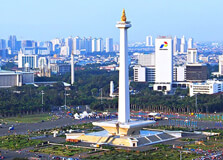
The National Monument, or Monas (Monumen Nasional), is one of Jakarta’s most iconic landmarks. Standing at 132 meters (433 feet), Monas is a towering symbol of Indonesia's struggle for independence. The monument is located in the heart of Jakarta, within Merdeka Square, and it is a prominent feature of the city’s skyline. The National Monument is not just a structure; it is a symbol of the spirit and resilience of the Indonesian people, representing the country’s long and hard-fought journey to independence from Dutch colonial rule. It is one of the most visited tourist attractions in Indonesia and is a must-see for anyone visiting Jakarta. How to Reach National Monument, Jakarta The National Monument is centrally located in Jakarta, making it easily accessible from various parts of the city. If you are traveling by car or taxi, you can reach the monument by heading towards Merdeka Square. The monument is situated near major roads like Jalan Medan Merdeka Selatan, and it is surrounded by other important landmarks in the city. If you prefer public transportation, the nearest TransJakarta Bus Rapid Transit (BRT) station is "Monas," which is a short walk from the monument. You can also take the commuter train (KRL) to the Gambir station, which is just a 10-minute walk from the National Monument. Ride-hailing services like Gojek or Grab are also convenient options for reaching Monas directly. Weather at National Monument, Jakarta Jakarta experiences a tropical climate, and the weather around the National Monument is generally hot and humid throughout the year. The average temperature ranges from 25°C to 32°C (77°F to 89°F). Jakarta has two seasons: the rainy season (from November to March) and the dry season (from April to October). The dry season is typically the best time to visit Monas as the weather is more comfortable for outdoor activities. If you plan to visit during the rainy season, be prepared for heavy showers and bring an umbrella or raincoat. It’s advisable to check the weather forecast before your visit, especially if you plan to go up the monument for a panoramic view of Jakarta. Timing and Opening Hours of National Monument, Jakarta The National Monument is open daily from 8:00 AM to 4:00 PM. Visitors can explore the park surrounding the monument at any time during these hours, but the ticket counter for the monument itself closes at 4:00 PM. It’s important to note that the monument and its surrounding park can get crowded on weekends and public holidays, especially in the late morning and afternoon. To avoid the crowds and to enjoy a more peaceful experience, it’s best to visit early in the morning. If you wish to visit the top of the monument, make sure to arrive early enough to get in line, as it can take some time to access the elevator for the ride to the top, especially during peak hours. Why National Monument, Jakarta is Famous The National Monument is famous for its historical and cultural significance. It was built to commemorate Indonesia’s fight for independence from Dutch colonial rule and to honor the struggles and sacrifices made by the Indonesian people in achieving independence. The monument was inaugurated on August 17, 1975, Indonesia’s Independence Day, and it remains one of the country's most important national symbols. Its iconic flame-shaped gold sculpture at the top represents the spirit of freedom and independence. Aside from its historical value, the monument also offers panoramic views of Jakarta, making it a popular tourist destination. It is located in the heart of the city, within Merdeka Square, and is surrounded by government buildings, parks, and museums, further enhancing its prominence. Entry and Visit Details about National Monument, Jakarta Entry to the National Monument park is free of charge, so visitors can freely walk around and explore the area. However, to access the monument’s observation deck at the top, visitors are required to purchase tickets. The ticket prices are relatively affordable, with different pricing for adults and children. As of recent reports, the general entry fee for the monument is around IDR 20,000 (approximately USD 1.30) for adults, and a discounted fee is available for students and children. The ticket grants access to the monument’s base as well as the elevator ride to the observation deck, where you can enjoy spectacular views of Jakarta. Additional fees may apply if you wish to visit nearby attractions, such as museums or exhibitions within the complex. History and Architecture of National Monument, Jakarta The National Monument was conceived during the presidency of Sukarno, the first president of Indonesia, as a symbol of the nation's independence. Construction began in 1961 and was completed in 1975. The monument was designed by the Indonesian architect Soedarsono and stands on the site of a former colonial building. The design of the National Monument is a striking blend of modernist and traditional Indonesian architectural styles. The base of the monument features a large plaza, and the obelisk-like structure rises to 132 meters, topped by a golden flame that symbolizes the country’s enduring spirit of independence. At the base of the monument, there is a museum that tells the story of Indonesia’s struggle for independence. The museum houses various historical artifacts, dioramas, and photographs that illustrate key events in the country’s history. The observation deck at the top of the monument offers 360-degree views of Jakarta and is an ideal spot for taking photos of the city’s skyline and landmarks. Things to Do at National Monument, Jakarta There are several activities you can enjoy while visiting the National Monument: Visit the Observation Deck: Take the elevator to the top of the National Monument for a breathtaking panoramic view of Jakarta. From here, you can see the city’s sprawling urban landscape, as well as nearby attractions like Merdeka Square, the Presidential Palace, and the Jakarta skyline. Explore the Museum: The museum at the base of the monument provides fascinating insights into Indonesia’s journey to independence, with exhibits that include historical artifacts, maps, and photographs. Stroll Around the Park: The area surrounding the National Monument is a large, open park where visitors can relax, take a leisurely walk, or enjoy a picnic. The park is also home to fountains and sculptures that add to the beauty of the area. Learn About Indonesian History: Take the time to learn about Indonesia’s history and independence by exploring the nearby museums, such as the Museum of the History of Jakarta and the National Museum. Attend National Events: Merdeka Square, where the National Monument is located, is the site of national celebrations, such as Independence Day on August 17th. These events include parades, cultural performances, and ceremonies that attract thousands of people. Facts about National Monument, Jakarta The National Monument stands at a height of 132 meters (433 feet) and is one of the tallest monuments in Southeast Asia. The golden flame at the top of the monument weighs 14.5 tons and is made of bronze, covered in gold. The monument is located within a large park area that covers approximately 80 hectares (200 acres) in the center of Jakarta. The base of the National Monument features a museum that showcases Indonesia’s struggle for independence, with more than 50 dioramas and historical exhibits. On the 17th of August each year, Merdeka Square hosts a grand Independence Day celebration, with events centered around the National Monument. Tips for Visiting National Monument, Jakarta Visit Early: To avoid large crowds and long wait times for the elevator to the top, it’s best to visit early in the day, especially on weekdays. Wear Comfortable Shoes: You’ll be walking around the monument’s park and surrounding area, so comfortable footwear is essential. Bring Water and Snacks: Jakarta can be hot and humid, so be sure to stay hydrated. You may want to carry water and light snacks, especially if you plan to explore the park for a while. Check the Weather: Since the National Monument is an outdoor attraction, it’s a good idea to check the weather before your visit. The dry season (April to October) is the best time to visit. Be Respectful: The National Monument is a symbol of national pride for Indonesians, so be respectful of the monument and the surrounding areas while visiting.
Explore More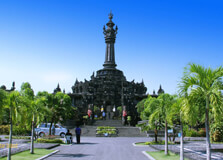
The Bajra Sandhi Monument is a grand landmark located in the heart of Denpasar, Bali’s capital city. This iconic structure is dedicated to the struggles of the Balinese people throughout history, particularly during their fight for independence. Designed in the shape of a "bajra" (a Hindu priest’s bell), the monument symbolizes the spirit, resilience, and unity of the Balinese people. Surrounded by lush gardens and peaceful lakes, Bajra Sandhi Monument is not just a historical attraction but also a beautiful place to relax, learn, and enjoy panoramic views of the city. How to Reach Bajra Sandhi Monument, Denpasar Bajra Sandhi Monument is located in the Renon area of Denpasar, inside the large civic park known as **Lapangan Puputan Renon**. By Air: The monument is about 15 kilometers from Ngurah Rai International Airport and takes around 30–40 minutes by car. By Taxi/Ride-hailing: You can easily get a Grab, Gojek, or Blue Bird taxi from most parts of South Bali. Input “Bajra Sandhi Monument” as your destination. By Car or Scooter Rental: Renting a vehicle allows for more flexibility. Follow Jalan By Pass Ngurah Rai north to Jalan Raya Puputan. Public Transport: Local buses (Trans Sarbagita) and bemo (minibuses) go to Renon from downtown Denpasar and other nearby cities. Weather at Bajra Sandhi Monument, Denpasar Denpasar has a tropical climate with warm temperatures and high humidity year-round. Average daytime temperatures range between **27°C and 32°C (81°F – 89°F)**. - **Dry season (May to September):** Sunny skies and cooler breezes, ideal for walking around the park and enjoying rooftop views. - **Wet season (October to April):** Expect short but heavy afternoon rains, though mornings are often still clear. Bring an umbrella or light raincoat if visiting during these months. Timings Bajra Sandhi Monument is open daily except for national holidays. - **Monday to Friday:** 8:00 AM – 4:30 PM - **Saturday and Sunday:** 10:00 AM – 4:00 PM - Last entry is usually 30 minutes before closing time. Why Famous for Bajra Sandhi Monument, Denpasar? Bajra Sandhi Monument is famous for several reasons: Symbol of Balinese struggle: It honors the long history of Balinese resistance and cultural preservation. Unique architecture: The monument’s bell shape is modeled after a Hindu priest’s bajra, making it spiritually significant. Cultural exhibits: Inside the monument is a museum featuring dioramas that vividly depict Bali’s history, from ancient kingdoms to the modern era. Panoramic views: The top floor offers a 360-degree view of Denpasar and the surrounding areas. Popular park setting: The surrounding Renon Park is a favorite local spot for jogging, walking, and family gatherings. Entry and Visit Details about Bajra Sandhi Monument, Denpasar - **Entry fee:** Approximately IDR 25,000 for foreign adults and IDR 10,000 for children. Discounts may apply to groups or students. - **Tickets:** Can be purchased at the entrance gate. No need for advance booking. - **Facilities:** Parking area, toilets, small souvenir stalls, and drink vendors are available near the entrance. - **Dress code:** Modest and comfortable clothing is recommended, especially if you plan to climb to the viewing deck. History and Architecture The monument was first conceptualized in **1980** and completed in **2001**. It was officially opened to the public by Indonesia’s then-president Megawati Sukarnoputri. The idea behind the monument was to create a structure that would symbolize the bravery, unity, and spirit of the Balinese people throughout their history. Architecturally, the monument is designed in a **bajra** shape, a bell traditionally used by Hindu priests during rituals. It rises **45 meters** above ground and features multiple levels. The layout follows Balinese philosophical and architectural principles known as **Tri Mandala**, which divide the space into three zones: Utama Mandala (Main Chamber): The top floor provides a viewing area with panoramic vistas of Denpasar. Madya Mandala (Middle Zone): The museum area with 33 dioramas depicting Balinese history, struggles, and achievements. Nista Mandala (Outer Zone): The surrounding park and entry grounds for public recreation and events. Things to Do at Bajra Sandhi Monument, Denpasar Explore the museum: Walk through historical dioramas that narrate major events in Balinese history, from early kingdoms to Dutch colonization. Climb to the top: Reach the observation deck via spiral stairs to enjoy panoramic views of Denpasar city and even Mount Agung on clear days. Relax at Renon Park: The wide lawns and shaded paths make this a great place to walk, jog, or picnic with locals. Photography: Capture beautiful images of the monument, especially during sunrise or sunset. Attend events: Occasionally, the park hosts exhibitions, concerts, and cultural events, especially on Independence Day and major Balinese festivals. Facts about Bajra Sandhi Monument, Denpasar The monument contains **33 dioramas** illustrating important chapters in Bali’s history. The structure is 45 meters high, symbolizing Indonesia's independence in 1945. The site is used for national day celebrations, including **Indonesian Independence Day** on August 17th. The design was created by Balinese architect **Ida Bagus Gede Yadnya**, who combined traditional Balinese elements with modern engineering. It is one of the most visited monuments in Bali and serves as a center for civic pride and education. Tips about Bajra Sandhi Monument, Denpasar Visit in the morning or late afternoon for cooler temperatures and better light for photos. Wear comfortable shoes as you'll be climbing several flights of stairs to reach the top viewing deck. Bring a bottle of water and light snacks, especially if you plan to walk around Renon Park. Don’t rush—take time to read the explanations provided for each diorama inside the museum. Try to combine your visit with nearby attractions like the Bali Museum or Jagatnatha Temple for a full cultural day in Denpasar. Watch for joggers and cyclists in the park; mornings are quite busy with locals exercising.
Explore More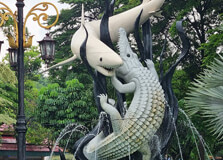
The Suroboyo Monument is one of the most iconic landmarks in Surabaya, Indonesia. This monument features a striking sculpture of a shark (Suro) and a crocodile (Boyo), symbolizing the legendary origins of the city's name. The monument is a must-visit attraction, representing the bravery and fighting spirit of the people of Surabaya. How to Reach Suroboyo Monument, Surabaya Suroboyo Monument is centrally located in Surabaya, making it easily accessible by various transportation options: Public Transport: City buses and angkot (shared minivans) frequently pass by the monument. Ride-Hailing Services: Apps like Gojek and Grab provide convenient transportation options. Private Vehicles: Visitors can drive their own cars or motorcycles, with parking areas available nearby. Weather in Suroboyo Monument, Surabaya Surabaya experiences a tropical climate with warm temperatures year-round. The average temperature ranges between 26°C to 34°C (79°F to 93°F). The best time to visit is during the dry season from May to September, as the wet season (October to April) brings heavy rains. Timing and Best Time to Visit Suroboyo Monument is accessible 24 hours a day as it is located in an open public space. However, the best time to visit is during the early morning or late evening to enjoy the view without the harsh midday sun. At night, the monument is beautifully illuminated, making it a perfect spot for photography. Why is Suroboyo Monument Famous? The Suroboyo Monument is famous for its unique depiction of a shark and a crocodile, which are deeply connected to the legend of Surabaya’s name. The monument is a symbol of resilience, strength, and the historical spirit of the city. It is also a popular spot for tourists, photographers, and locals who want to experience a piece of Surabaya’s heritage. Entry and Visit Details As an open public attraction, the Suroboyo Monument does not require an entry fee. Visitors can enjoy the site freely and take pictures. However, they should be mindful of the following: The area around the monument can be crowded during weekends and holidays. Visitors are encouraged to respect the surroundings and avoid littering. There are nearby parks and recreational areas where visitors can relax and enjoy the view. History and Architecture The monument was created to depict the legendary battle between the shark (Suro) and the crocodile (Boyo), which led to the name “Surabaya.” The design showcases the two creatures locked in combat, symbolizing the strength and courage of Surabaya’s people. The sculpture is made of durable materials, ensuring that it remains a lasting landmark in the city. Things to Do at Suroboyo Monument Visitors can enjoy several activities around the monument, including: Photography: Capture stunning pictures of the iconic monument, especially at night when it is illuminated. Relaxing in Nearby Parks: The monument is located near parks where visitors can sit and enjoy the surroundings. Exploring Surabaya’s History: Learn more about the legend of Suro and Boyo and its significance to the city. Trying Local Street Food: Enjoy nearby food stalls offering delicious Indonesian snacks. Interesting Facts and Tips Facts: The Suroboyo Monument is one of the most photographed landmarks in Surabaya. The shark and crocodile battle is an ancient Javanese legend symbolizing the struggles faced by the city. The monument is often used as a meeting point for locals and tourists. Tips: Visit in the early morning or evening to avoid the heat and crowds. Be cautious while taking pictures, as the monument is located near a busy road. Combine your visit with nearby attractions like the Surabaya Zoo or Bungkul Park. Respect the monument and its surroundings by keeping the area clean.
Explore More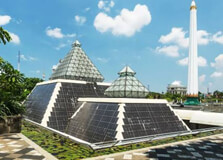
Tugu Pahlawan, or the Heroes Monument, is one of the most significant landmarks in Surabaya, Indonesia. It was built to commemorate the bravery and sacrifice of Indonesian freedom fighters during the Battle of Surabaya on November 10, 1945. This towering monument stands as a symbol of Indonesia’s struggle for independence and attracts many visitors interested in history and patriotism. How to Reach Tugu Pahlawan, Surabaya The Heroes Monument is located in the center of Surabaya, making it easily accessible by various means of transportation: By Car or Motorcycle: Visitors can drive to the monument and find parking nearby. By Public Transport: City buses and angkot (shared minivans) have routes that stop near the monument. By Ride-Hailing Services: Apps like Gojek and Grab provide easy access to the site. Weather in Tugu Pahlawan, Surabaya Surabaya has a tropical climate with temperatures ranging from 26°C to 34°C (79°F to 93°F). The best time to visit is during the dry season (May to September), as the rainy season (October to April) may bring occasional heavy showers. Timing and Best Time to Visit The monument is open daily from 8:00 AM to 4:00 PM. The best time to visit is in the morning or late afternoon to avoid the heat. Visiting on November 10, Indonesia’s National Heroes Day, offers a unique experience as ceremonies and events take place. Why is Tugu Pahlawan Famous? Tugu Pahlawan is famous for its historical significance. It was built to honor the heroes who fought against British and Dutch forces in 1945. The 41-meter-tall monument symbolizes the determination of the Indonesian people in their fight for independence. Entry and Visit Details Visitors should take note of the following details: Entry Fee: Free to visit the monument; a small fee applies for entry into the museum. Dress Code: Casual and comfortable clothing is recommended. Photography: Allowed and encouraged, especially for history enthusiasts. History and Architecture Built in 1952 by Indonesia’s first president, Sukarno, the monument features a unique design resembling an inverted nail, symbolizing the spirit of resistance. Surrounding the monument are statues and reliefs depicting the Battle of Surabaya. Things to Do at Tugu Pahlawan Visitors can enjoy several activities: Explore the Monument: Walk around and admire the historical statues and reliefs. Visit the Museum: Learn about Indonesia’s struggle for independence through exhibits and dioramas. Photography: Capture the stunning architecture and historical elements. Attend Ceremonies: Experience patriotic events, especially on National Heroes Day. Interesting Facts and Tips Facts: Tugu Pahlawan is the most important war memorial in East Java. The monument was built on the site where many Indonesian fighters lost their lives. The adjacent museum houses relics from the Battle of Surabaya. Tips: Visit early in the morning to avoid crowds and heat. Take time to explore the museum for a deeper understanding of Indonesia’s history. Respect the solemnity of the site as it is a national monument.
Explore More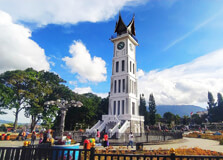
Jam Gadang is a historic clock tower located in the heart of Bukittinggi, a city in West Sumatra, Indonesia. The name "Jam Gadang" translates to "Big Clock" in the Minangkabau language. Standing tall at approximately 26 meters (85 feet), this iconic landmark is not just a timekeeping structure, but also a symbol of the city's heritage and cultural identity. Surrounded by a park and bustling town square, Jam Gadang is one of the most visited and photographed spots in Sumatra. How to Reach Jam Gadang, Bukittinggi Bukittinggi is located about 95 kilometers from Padang, the capital city of West Sumatra. The nearest airport is Minangkabau International Airport (PDG) in Padang. From the airport, travelers can reach Bukittinggi by taxi, car rental, or intercity buses. The drive takes approximately 2.5 to 3 hours, offering scenic views of hills, rice fields, and traditional villages along the way. Once in Bukittinggi, Jam Gadang is located in the city center and can easily be reached on foot or by local transport like "angkot" (shared minivan). Weather in Bukittinggi Bukittinggi enjoys a mild tropical climate due to its elevation of around 930 meters above sea level. Temperatures range between 16°C to 28°C (60°F to 82°F) throughout the year. The weather is generally cooler than most Indonesian cities, making it a comfortable destination year-round. The rainy season typically occurs between November and April, while the dry season runs from May to October. It’s best to check the forecast before visiting to enjoy outdoor sightseeing comfortably. Timing of Jam Gadang Jam Gadang is an open public space and is accessible 24 hours a day. While the clock tower itself cannot be entered, the surrounding area is popular for walks, photography, and local events. The best time to visit is during the morning or late afternoon to avoid the midday heat. In the evening, the tower is illuminated with colorful lights, making it a great time for photos and enjoying the night market nearby. Why is Jam Gadang Famous? Jam Gadang is famous not only for its unique architecture and giant clock, but also for its cultural and historical significance. It is a central landmark in Bukittinggi and a symbol of pride for the Minangkabau people. The clock was a gift from Queen Wilhelmina of the Netherlands during the Dutch colonial era. What makes it even more special is the Roman numeral representation on the clock face — the number "4" is written as "IIII" instead of the usual "IV", a rare stylistic choice in timepiece design. Entry and Visit Details There is no entry fee to visit the Jam Gadang area, as it is located in an open square. Visitors can stroll around the tower, enjoy the gardens, and shop at the nearby local stalls. The area is safe for tourists and is often patrolled by local police and security. While entry into the tower itself is restricted to protect its structure, there are plenty of photo opportunities and cultural attractions around the site, including street performances and food vendors. History and Architecture Jam Gadang was built in 1926 by the Dutch colonial government. The clock mechanism was reportedly imported from Rotterdam, made by Vortmann Recklinghausen, a famous clock manufacturer in Germany. The structure originally had a rooster weathervane at its peak, which was later changed into a dome during the Japanese occupation and eventually into the traditional Minangkabau roof after independence. The current design reflects the local Minangkabau architecture with its iconic curved roof resembling buffalo horns. The building has survived several earthquakes, and its enduring presence tells the story of the city’s colonial, wartime, and post-independence periods. Things to Do Around Jam Gadang There is plenty to explore around Jam Gadang. Visitors can shop at the nearby Pasar Atas and Pasar Bawah markets, which offer traditional handicrafts, local snacks, and souvenirs. Street vendors and food stalls serve authentic West Sumatran dishes like rendang, sate padang, and various spicy sambals. Families can enjoy horse-drawn carriage rides or visit the nearby "Taman Panorama" park for views of the Sianok Canyon. Fort de Kock, a historic Dutch fort, is also a short walk away. The Bukittinggi Zoo and the Lobang Jepang (Japanese Caves) are additional attractions in the area. Facts and Tips about Jam Gadang, Bukittinggi Interesting Facts: - The clock tower's face features the number four as “IIII” instead of “IV”. - Jam Gadang has had three different roof designs throughout history. - The tower was a gift from the Dutch Queen to the city’s secretary. - The clock's mechanism is one of only two of its kind in the world. - It is a popular spot for national celebrations and New Year’s Eve events. Tips for Visitors: - Visit in the early morning or late afternoon for the best lighting for photos. - Carry some cash as most vendors do not accept cards. - Be respectful of local customs, especially during prayer times or holidays. - Watch out for street performers or cultural shows that often take place near the tower. - Wear comfortable footwear as the area is best explored on foot.
Explore More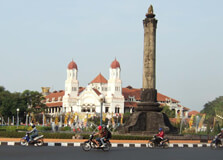
Tugu Muda is one of Semarang’s most iconic landmarks. Located in the heart of the city, this historical monument is dedicated to the heroes who fought during Indonesia’s independence struggle. The monument stands as a symbol of patriotism and national pride, making it a must-see attraction for anyone visiting Semarang. Its unique design and significant historical value attract tourists, locals, and history enthusiasts alike. How to Reach Tugu Muda, Semarang Tugu Muda is located in the center of Semarang, making it easily accessible from various parts of the city. Here are some ways to reach this iconic monument: By Air: The nearest airport to Tugu Muda is Ahmad Yani International Airport (SRG). From the airport, you can take a taxi or use a ride-hailing app such as Grab or Gojek to reach Tugu Muda in approximately 20 minutes. By Taxi or Private Car: If you're already in Semarang, Tugu Muda is easily accessible by taxi or private car. The monument is located on Jalan Pahlawan, which is well connected to other main roads of the city. By Public Transport: Semarang has an extensive public transport system, including buses and angkots (minivans). You can take a bus that passes through the city center and get off at Tugu Muda. On Foot: If you are staying near the city center, Tugu Muda is within walking distance from various attractions such as Lawang Sewu and Simpang Lima. It’s a great place to start a walking tour of Semarang’s historical sites. Weather and Best Time to Visit Tugu Muda Semarang has a tropical climate, with hot and humid weather year-round. The average temperature typically ranges from 24°C (75°F) to 32°C (90°F). The best time to visit Tugu Muda is during the dry season, which lasts from May to September. During this time, you can expect clear skies and sunny weather, ideal for outdoor sightseeing. However, Tugu Muda remains open year-round, and even during the rainy season (October to April), visitors can enjoy the monument. Just be prepared for occasional downpours and bring an umbrella or raincoat. Why Famous for Tugu Muda, Semarang? Tugu Muda is famous for several reasons. Primarily, the monument commemorates the bravery and sacrifices of the people of Semarang who fought for Indonesia's independence from Dutch colonial rule. The name "Tugu Muda" translates to "Youth Monument," symbolizing the role of the youth in the struggle for independence. The monument was erected in 1953 to honor the historical event known as the "Semarang Battle" or "Perang Semarang," which occurred in 1945. The battle was one of the significant conflicts in the Indonesian National Revolution, where the youth of Semarang played a crucial role in fighting against the Dutch colonial forces. Tugu Muda’s architectural style is also notable. The monument stands tall with a central column that is surrounded by smaller columns, and it features various symbolic carvings representing the struggle for freedom. It’s a powerful symbol of Indonesia’s national identity and the spirit of independence. Entry and Visit Details about Tugu Muda Tugu Muda is a public monument, and entry is free for visitors. There are no official operating hours, as the monument is always open for public viewing. However, it is recommended to visit during daylight hours for the best experience, especially if you're interested in taking photos and exploring the surrounding area. The monument is located in a public square with a well-maintained park, offering a pleasant place to relax and take in the historical atmosphere. While visiting, you can also enjoy the nearby attractions, such as Lawang Sewu and Simpang Lima, which are just a short distance away. History and Architecture of Tugu Muda The construction of Tugu Muda was part of a national effort to commemorate the heroes who fought in the Semarang Battle and other significant events of Indonesia’s independence struggle. The monument was officially inaugurated in 1953 by then-Indonesia President Sukarno, making it an important historical landmark in the country. Architecturally, Tugu Muda features a tall central column representing the spirit and courage of the Indonesian youth who fought for the country’s independence. Surrounding the column are several smaller columns, each symbolizing the unity and strength of the Indonesian people during the revolution. The monument’s design incorporates elements of modernist architecture, while also paying tribute to traditional Indonesian motifs and symbols of patriotism. The monument’s base is adorned with carvings that depict scenes from the Semarang Battle and other pivotal moments in Indonesian history. These carvings not only showcase the rich cultural heritage of Indonesia but also serve as a reminder of the sacrifices made by the nation’s heroes. Things to Do at Tugu Muda Photography: Tugu Muda offers excellent opportunities for photography. The monument’s unique design and historical significance make it a popular subject for both amateur and professional photographers. Capture the monument from different angles to highlight its grandeur and symbolism. Relax in the Park: The area surrounding Tugu Muda is a well-maintained park, making it a great spot to sit, relax, and enjoy the view. Locals often gather here, especially in the evenings, to unwind after a long day. Explore Nearby Attractions: Tugu Muda is located near several other notable attractions in Semarang. Visit Lawang Sewu, a historical building with stunning colonial architecture, or take a walk around Simpang Lima, a popular city square that’s bustling with activity. Attend Cultural Events: Tugu Muda is sometimes used as a venue for cultural events, performances, and ceremonies. Check local listings to see if there are any special events happening during your visit. Interesting Facts About Tugu Muda The monument was built to commemorate the Semarang Battle (Perang Semarang) in 1945, one of the key events in Indonesia’s fight for independence. Tugu Muda’s name, "Youth Monument," reflects the role that the youth of Semarang played in the battle and the revolution. The monument is made up of a central column and several smaller columns, symbolizing unity, patriotism, and the spirit of Indonesia's independence struggle. Tugu Muda is located in a public square, surrounded by a park where locals gather and relax. It’s an ideal spot to enjoy a peaceful afternoon in Semarang. The monument has become an important symbol of Semarang and is often used in various cultural and civic ceremonies, including Independence Day celebrations. Tips for Visiting Tugu Muda Visit Early or Late: To avoid crowds, visit Tugu Muda early in the morning or later in the evening. The park and monument are quieter during these times, allowing you to enjoy the historical site without the rush of tourists. Take a Guided Tour: If you want to learn more about the history of Tugu Muda and its significance, consider hiring a local guide or joining a walking tour of Semarang’s historical sites. Bring a Camera: Tugu Muda offers great photo opportunities, so don’t forget to bring your camera or smartphone to capture the monument and the surrounding area. Wear Comfortable Shoes: The area around Tugu Muda is pedestrian-friendly, but make sure to wear comfortable shoes, especially if you plan on walking to nearby attractions such as Lawang Sewu. Respect the Monument: As Tugu Muda is a national landmark and a symbol of Indonesia’s independence, always show respect during your visit. Avoid littering and be mindful of the surroundings. Conclusion Tugu Muda is more than just a monument; it is a symbol of Indonesia’s independence struggle and a testament to the bravery of the youth who played a key role in the revolution. The monument’s grand architecture, historical significance, and central location make it one of Semarang’s most important landmarks. Whether you’re a history enthusiast, an architecture lover, or simply someone looking to explore the rich heritage of Semarang, Tugu Muda is a must-visit destination.
Explore More